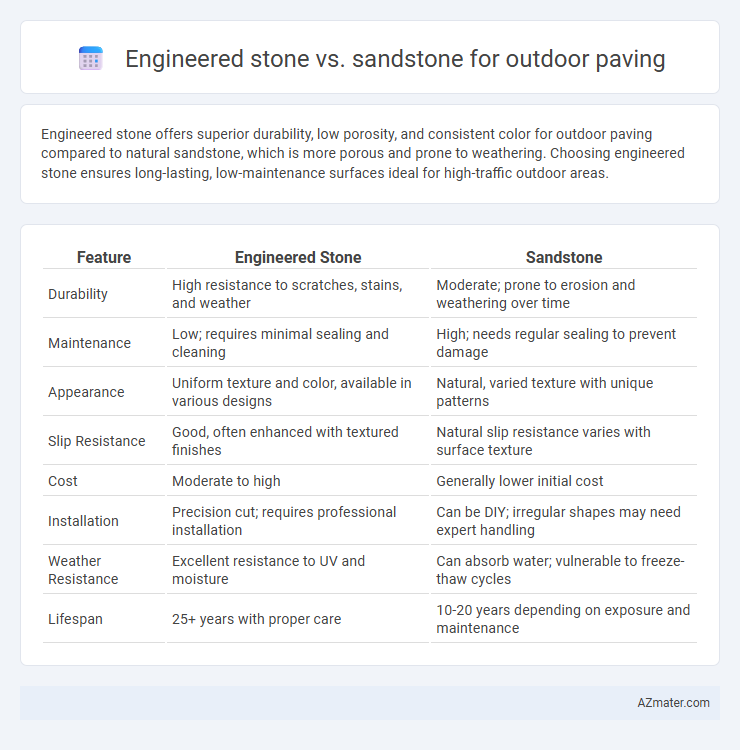Engineered stone offers superior durability, low porosity, and consistent color for outdoor paving compared to natural sandstone, which is more porous and prone to weathering. Choosing engineered stone ensures long-lasting, low-maintenance surfaces ideal for high-traffic outdoor areas.
Table of Comparison
| Feature | Engineered Stone | Sandstone |
|---|---|---|
| Durability | High resistance to scratches, stains, and weather | Moderate; prone to erosion and weathering over time |
| Maintenance | Low; requires minimal sealing and cleaning | High; needs regular sealing to prevent damage |
| Appearance | Uniform texture and color, available in various designs | Natural, varied texture with unique patterns |
| Slip Resistance | Good, often enhanced with textured finishes | Natural slip resistance varies with surface texture |
| Cost | Moderate to high | Generally lower initial cost |
| Installation | Precision cut; requires professional installation | Can be DIY; irregular shapes may need expert handling |
| Weather Resistance | Excellent resistance to UV and moisture | Can absorb water; vulnerable to freeze-thaw cycles |
| Lifespan | 25+ years with proper care | 10-20 years depending on exposure and maintenance |
Introduction to Outdoor Paving Materials
Engineered stone offers superior durability and low maintenance for outdoor paving compared to natural sandstone, which is more porous and prone to weathering. Sandstone provides a natural aesthetic with unique textures and colors, but requires regular sealing to prevent erosion and staining. Choosing between engineered stone and sandstone depends on balancing long-term performance with desired visual appeal in outdoor environments.
What Is Engineered Stone?
Engineered stone is a composite material made from crushed natural quartz bound together with resin and pigments, offering superior durability and low porosity compared to sandstone. Its non-porous surface resists staining, weathering, and frost damage, making it ideal for outdoor paving applications. Unlike sandstone, engineered stone allows for greater color consistency and requires minimal maintenance while providing a hard, wear-resistant surface.
Understanding Natural Sandstone
Natural sandstone, formed from compacted sand grains bound by mineral cement, offers unique textures and colors ideal for outdoor paving, providing authentic aesthetic appeal and natural weather resistance. Its porosity varies, impacting durability and maintenance, with denser sandstone types better suited for high-traffic outdoor areas due to enhanced strength and reduced water absorption. Unlike engineered stone, which integrates resin for uniformity and enhanced durability, natural sandstone requires sealing to prevent staining and erosion while preserving its organic look and ecological footprint.
Aesthetic Differences: Engineered Stone vs Sandstone
Engineered stone offers a consistent color palette and uniform texture, making it ideal for modern outdoor paving designs that require precision and sleek aesthetics. Sandstone displays natural variations in color and grain, providing a rustic and organic appearance that enhances traditional or natural landscapes. The durability of engineered stone ensures sustained visual appeal, while sandstone's weathering can create a unique patina over time, adding character to outdoor spaces.
Durability and Weather Resistance Comparison
Engineered stone offers superior durability and enhanced weather resistance compared to sandstone, making it a more resilient choice for outdoor paving. Its composite materials provide high resistance to cracking, chipping, and fading under extreme temperature variations and UV exposure, unlike natural sandstone which is more porous and susceptible to erosion and staining. Engineered stone's low water absorption rate prevents freeze-thaw damage, ensuring long-lasting performance in harsh climatic conditions where sandstone may deteriorate over time.
Maintenance Requirements for Each Material
Engineered stone requires minimal maintenance due to its non-porous surface, making it resistant to stains, mold, and weather damage, ideal for long-term outdoor paving. Sandstone, being naturally porous, demands regular sealing and cleaning to prevent water absorption, erosion, and biological growth, which can deteriorate its appearance and structural integrity over time. Choosing engineered stone significantly reduces upkeep efforts and costs compared to the ongoing maintenance sandstone necessitates in outdoor environments.
Cost Analysis: Upfront and Long-Term Expenses
Engineered stone for outdoor paving typically involves higher upfront costs due to manufacturing processes and material quality, but it offers durability and low maintenance, reducing long-term expenses. Sandstone presents a lower initial investment, yet it requires more frequent sealing and repairs to prevent weathering and erosion, increasing lifetime maintenance costs. Evaluating total cost of ownership, engineered stone often proves more economical over time despite its initial price premium.
Ease of Installation: Engineered Stone vs Sandstone
Engineered stone offers greater ease of installation for outdoor paving due to its uniform size, consistent thickness, and precisely cut edges, allowing for faster and more accurate laying. Sandstone, being a natural material, varies in shape, size, and thickness, which can complicate installation and require additional cutting and fitting. The predictable dimensions of engineered stone reduce labor time and the need for specialized tools compared to the irregularity of sandstone slabs.
Environmental Impact and Sustainability
Engineered stone for outdoor paving offers a lower environmental impact due to its use of recycled materials and reduced quarrying compared to natural sandstone. Sandstone, while durable and naturally sourced, often involves significant ecological disruption and higher carbon emissions during extraction and transportation. Selecting engineered stone supports sustainability by minimizing resource depletion and promoting eco-friendly manufacturing practices.
Choosing the Best Option for Your Outdoor Space
Engineered stone offers superior durability and low maintenance for outdoor paving, resisting stains and weathering better than natural sandstone. Sandstone provides a natural, textured aesthetic with unique color variations, enhancing outdoor spaces with organic charm but requires regular sealing to prevent erosion. Choosing the best option depends on balancing long-term maintenance needs and the desired visual appeal for your outdoor environment.

Infographic: Engineered stone vs Sandstone for Outdoor Paving
 azmater.com
azmater.com